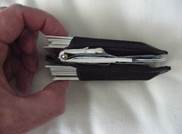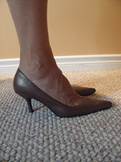
Tsawwassen Massage Therapy
Mike’s Top Ten Tips for Reducing Back Pain
The following article explains ways of preventing, reducing or eliminating back pain. I have found them to be very useful to myself, my clients and my patients.
-
Perform daily back extension exercises.
A lot of back pain is generated from bulging discs. Discs typically bulge posteriorly or backwards (no pun intended). Back extension exercises help to move the bulge forward again. This reduces the pressure on the annulus (outer fibres) of the disc and allows the nucleus (inner gel-like substance) to move forward. You can improve disc health and reduce back pain by performing 15 back extensions twice a day, every day, or after prolonged sitting at a desk or in a car.
To perform back extensions, stand up straight with your feet shoulder-width apart. Place your hands on your lower back,
and then bend backwards to your point of comfort. Repeat 15 times. Another way to perform a similar exercise
stand up straight with your feet shoulder-width apart. Place your hands on your lower back,
and then bend backwards to your point of comfort. Repeat 15 times. Another way to perform a similar exercise is to do a push-up, arching your back while pushing your upper body away from
the floor.
is to do a push-up, arching your back while pushing your upper body away from
the floor. -
Lift properly.
Improper lifting will increase the pressure on the disc in the lumbar spine up to 400%. In other words, lifting 50 lbs incorrectly can add 200 lbs of compression on the discs, which may be enough to rupture the disc if the disc is already compromised. Disc ruptures and bulges are a major source of back pain and disability.
 Always bend your knees and keep your back straight when attempting to lift a heavy object. Never attempt to lift weight
beyond your ability.
Always bend your knees and keep your back straight when attempting to lift a heavy object. Never attempt to lift weight
beyond your ability. 
-
Fight gravity. Perform daily posture correction exercises.
Gravity tends to lead us to having poor posture over time. Poor posture includes head-forward carriage, rounding of the shoulders, forward rounding of the upper and mid back (Thoracic spine) and flattening of our low back (Lumbar spine). These positions put a lot of force onto the musculoskeletal systems, which eventually leads to back pain.
 To perform posture correction exercises, find a wall and place your heels against the base board and bend your knees slightly. You should feel the base of your spine and your shoulder blades touching the wall. Think tall and straighten up. Now tuck your chin in and try to touch the wall with the back of your head without extending you neck (lifting your chin). If you can’t, put a small pillow or towel in the space between the wall and the back of your head. Most people have slight head-forward posture. Do these exercises regularly and you can remarkably reduce and prevent back pain.
To perform posture correction exercises, find a wall and place your heels against the base board and bend your knees slightly. You should feel the base of your spine and your shoulder blades touching the wall. Think tall and straighten up. Now tuck your chin in and try to touch the wall with the back of your head without extending you neck (lifting your chin). If you can’t, put a small pillow or towel in the space between the wall and the back of your head. Most people have slight head-forward posture. Do these exercises regularly and you can remarkably reduce and prevent back pain.
- Keep active.
Your back needs oxygenated blood flowing to the muscles and surrounding tissues in order to eliminated toxins. Toxins in the tissues can cause muscles to tighten and even spasm. Tight muscles not only use up more energy because they are working too hard, they produce toxins that generate back pain. You can eliminate excessive toxins with aerobic exercise, which in turn improves circulation. Improve muscle health and reduce pain by going for a brisk walk or swim everyday. Save your back and heart. Get moving! - Insure proper biomechanics at your workstation.
Poor ergonomics at your work station can lead to repetitive strain injuries, as well as back, neck and shoulder pain.
Have your computer mouse close by so that you are not reaching, straining or rounding your shoulders. Your elbows should be close to your sides and your arms at a 90 degree angle. The computer screen should be at the same level as your eyes so that you are not extending your neck, which may generate tension headaches.
An adjustable height chair with a good lumbar support will help eliminate back pain. The chair height should be adjusted so that your hips are at the same level as your knees and your feet are firmly planted on the floor. This will prevent back and neck strain.
-
Do not sit on your wallet.
When you sit on your wallet it tilts your pelvis unequally, which not only puts stress your joints, but presses on your sciatic nerve. The sciatic nerve, when compromised, causes sharp pain that radiates into the low back and down the leg.
 Stay off of the wallet, so that it does not cost you in your wallet!
Stay off of the wallet, so that it does not cost you in your wallet!
- Limit the wearing of high heeled shoes.
High heels force your low back into extension (backward bending), which stresses the joints and intervertebral discs in the lumbar spine. This puts a lot of extra stress on the spine. Try limiting the use of the high heels to special occasions.
 If you must wear heels during your work-day, consider wearing a lower heal or a platform shoe.
If you must wear heels during your work-day, consider wearing a lower heal or a platform shoe.
- Correct sleeping posture.
Try to position yourself in proper spinal alignment before going to sleep. If you sleep on your side, put a pillow between your knees and a comfortable supportive pillow under your neck. If you typically sleep on your back, put a large pillow under your knees, which takes the stress off of the low back. Your pillow should be the right size so that your neck is in neutral position, not flexed (chin towards chest) or extended (neck bent backwards)
Try never to sleep on your stomach, as this causes your neck to be turned to one side or the other in order to breathe. Prolonged rotation of your neck will wreak havoc on your neck and back and may cause back pain. - Watch your weight.
Extra, unwanted weight adds to the compressive forces of the whole back, particularly the weight-bearing structures of the lumbar spine. The more weight you carry on your body, the more the lumbar spine tends to flatten out to support the added weight. This is called hypolordosis, the result of which adds compressive loads onto the intervertebral discs. The extra pressure on the discs can lead to tearing or rupturing of these discs. Reduce unwanted weight and save your discs and prevent back pain. For every extra pound you carry, adds at least 3 pounds of extra stress!
- Don’t ignore back pain. Treat your back better than your car.
There are many sources of back pain. If pain persists, see your massage therapist or other health care provider. It could be something as simple as a muscle strain or a nerve compression. A professional can provide you with a medical opinion and set you on the road to recovery and a pain-free back.
Most people treat they cars much better than their backs. Give your back regular maintenance and tune-ups and it will treat you well!That is all there is to it!
Follow the top ten tips and save yourself the grief of back pain.
References:
Joint Play the Right Way for the Axial Skeleton, by Mike Dixon RMT
Quick reference clinical Chiropractic Conditions Manual 1st and 2nd editions, By Nikita Vizniak, DC
Management of Common Musculoskeletal Disorders, 3rd edition by Hertling & Kessler
Orthopaedic and Physical Assessment 4th edition, by David J. Magee
To make an appointment with our highly qualified massage therapists in Tsawwassen, please contact us today!
